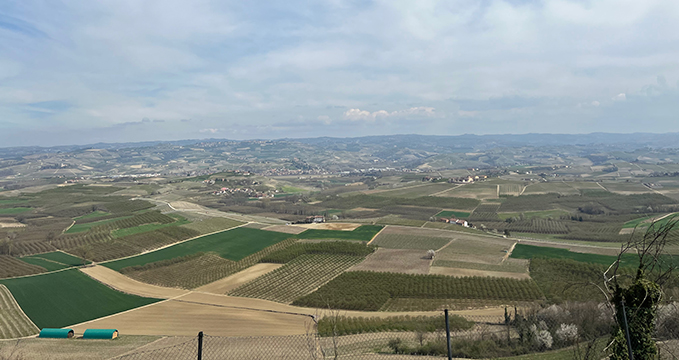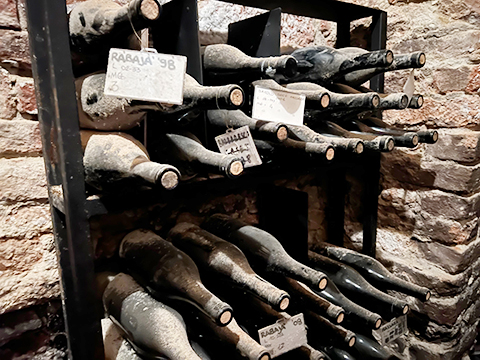Castello di Verduno, which owns vineyards in both Barolo and Barbaresco, is located in Verduno, the northernmost commune of Barolo. The estate is centered around the Castle of Verduno which was constructed in the early 1500s, and was owned by the royal House of Savoy until 1909 when it was bought by the Burlotto family.
The Azienda GB Burlotto was split apart to accommodate the heirs of Burlotto patriarch Giovanni Battista who had three sons. The property became three distinct wineries: Castello di Verduno, GB Burlotto and Cascina Massara.
Castello di Verduno expanded as the result of the marriage of Gabriella Burlotto to Barbaresco producer Franco Bianco. Today, the winery has five hectares in Verduno and five in Barbaresco.
One of the grapes that has received a lot of attention recently is Pelaverga Piccolo. It is only grown in the area around the town of Verduno. For many years it was neglected and forgotten in the shadow of noble Nebbiolo, an inconsequential blending grape often used in combination with Barbera and Dolcetto. It is a fresh, lighter red in the vein of cool climate Pinot Noir and offers a unique linear purity with bright red fruit dominated by sour cherry and a pronounced acidity. Castello di Verduno played a large role in the renaissance of the grape. In the early 1970s there were only a handful of Pelaverga Piccolo vines remaining when the Burlotto family at Castello di Verduno planted a section vineyard with Pelaverga. Since 2006 they also make a white wine from Pelaverga, quickly separating the juice from the skins following crushing.
 The estate is committed to traditional viticulture. They practice organic farming and low intervention in both the vineyard working with indigenous yeast and in the cellar using minimal SO2.
The estate is committed to traditional viticulture. They practice organic farming and low intervention in both the vineyard working with indigenous yeast and in the cellar using minimal SO2.
Grape Collective talks with winemaker Mario Andrion about the estate and the unique terroir of Verduno.
Tell us a little bit about the terroir in Verduno.
Verduno is one of the 11 villages in the appellation. And it is in the northern part. It's very particular, it's very unique. That is mainly due to the kind of soil because we have calcium like the Langhe, but with a higher percentage of sand and less of clay. This is a characteristic of the soil that gives to the grapes and after to the wine a very special and unique taste, especially when speaking about the quality of the tannins.
This shows a Barolo with not just a more soft and silky character, but also with much more salt and with silica copper. Moreover, it is very close to the Tanaro River valley, so that always allows a microclimate that is very warm during the summer, during the days of the summer. But in the evening and night, there is always very fresh air here from the Tanaro River valley. Having a great excursion of temperature between day and night can allow much more aromatic complexity in the wine. So at the end, we can say that the Barolo from Verduno is the most elegant expression.
How have things emerged in terms of the whole kind of dichotomy between modern and traditional in Barolo?
So Barolo has changed a lot and especially the perception of Barolo around the world, the change is in a good way. This is thanks to this sort of fight between modern and traditional that helped in a way with marketing the wine. People were very interested in say, okay, what is modern, what is traditional? I want to try modern and I want to try traditional. And so at the end of the day, Barolo became very famous.
 We work always in the traditional way. And I'm not very close to the taste of the modern style at the beginning of it, because I think that very few wineries were able to and had the knowledge of how to use barrique. And most of them use it just because it was more economically sustainable for their wineries, because people and sales were going that direction. But at the end, the wine didn't really show the purity or essence of the Nebbiolo. Castello Verduno for centuries always worked in a traditional way, so it does mean we always use the big Austrian and Slavonian oak and this is what we are still doing today.
We work always in the traditional way. And I'm not very close to the taste of the modern style at the beginning of it, because I think that very few wineries were able to and had the knowledge of how to use barrique. And most of them use it just because it was more economically sustainable for their wineries, because people and sales were going that direction. But at the end, the wine didn't really show the purity or essence of the Nebbiolo. Castello Verduno for centuries always worked in a traditional way, so it does mean we always use the big Austrian and Slavonian oak and this is what we are still doing today.
I think that at the end of the day the kind of fight between modern style and traditional helped the quality of the Barolo to rise up to an extremely high level. Because right now if you are still using a small oak, you know how to use it and make it outstanding wine. On the other hand, I think that the traditional way that used to use it, you would have a big casket but very often very old and sometimes even not very well sanitized. And they are taking much more care with these big barrels now. So, really the traditional style is more pleasant and refined than in the past. So I'm happy to be a sort of way to leave this period that helped all of us in the Langhe to reach a higher level.
Mario could you talk a little bit about the history of viticulture at Verduno?
So we have an approach that really did not change from the past to right now. The estate, and especially in the name of Franco Bianco, always acts in the vineyards with a lot of passion. And they're thinking about the vineyard like an extension of his house of the family. So he has been working in a sustainable and organic way even in the '70s when everything was allowed to use a very strong chemistry. But in this way, like I said, they're thinking about the vineyards like an extension of the house and they want to really have a healthy place.
 We are not certified organic, but we act organic and are very careful in terms of not using chemistry and herbicides and also to think about the vineyards as not a place like a factory of grapes where you have this place just to build your grapes. But then this is a place that is in nature, where different kinds of animals can find a place to stay, from the insects, birds and even bigger animals.
We are not certified organic, but we act organic and are very careful in terms of not using chemistry and herbicides and also to think about the vineyards as not a place like a factory of grapes where you have this place just to build your grapes. But then this is a place that is in nature, where different kinds of animals can find a place to stay, from the insects, birds and even bigger animals.
And then this kind of philosophy looks the same in the winery. So minimum intervention, we use wild yeast and use all these techniques that are traditional ones, so long contact skin in the open top wooden fermenters that we call tino. For many, many days or so, we reach even 90 days of contact skin from some Barolo and for the aging process we use only big Austrian or Slavonian oak, no fining and no filtration. The idea is that we make a lot of efforts in the vineyards to achieve the best quality of grape, so I don't want to be filtering to try to get out from the wine and all of the efforts that we did to have these beautiful grapes.
Pelaverga is a unique grape.
There actually are two wines called Pelaverga. The wines are completely different, the grapes are completely different. We did DNA analysis. So now Pelaverga from Verduno is called Pelaverga Piccolo because they are much smaller berries than the other one. It is very indigenous to this area and has nothing in common with the other one other than the name. The other is called Pelaverga di Pagno, named after a village. It is still in the province of Cuneo in Piedmont but it is closer to the Alps.
Talk a little bit about the very unique aging cellar you have at the castle.
So the cellar that we have here now at the castle below is a very historical one because we are speaking about a cellar from the 16th century. So a lot of wine passed through the cellar. And it was the good thinking of King Carlo Alberto, because the previous owner of the castle was the King of Savoia. He was making his own wine and now we are continuing to make it in the same place. It is very unique also because the condition of the cellar is perfect to age our wine. We have almost a constant the temperature between the summer and the winter, and great humidity which allows us to have beautifully long-aging wines.














